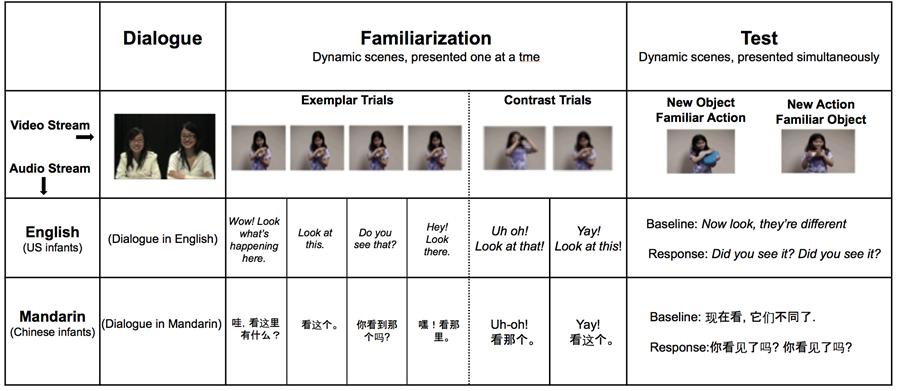Do cultures influence how we attend to the objects and actions that surround us? Past studies have suggested that it does. But how early culture-specific patterns of attention emerge in development?
A study which was led by Prof.WAXMAN Sandra’s research team from Northwestern University and Prof. FU Xiaolan’s team from the Institute of Psychology, Chinese Academy of Sciences directly addressed this issue. By using Eye-Tracking technique, they examined how24-month-old infant, who are on the threshold of learning words of objects and actions, deployed their attention to objects and actions when they are simply observing dynamic scenes.
At first, all infants watched a series of exemplar scenes (e.g., a girl petting a dog) in the familiarization phase. Then, infants watched new scenes in which either object was switched (the girl petting a pillow) or the action was switched (e.g., the girl kissing a dog) in the test phase (see Table 1). The results revealed striking convergences in infants’ patterns of visual attention in the two communities, while, pinpointed a brief period in the test phase during which their attention reliably diverged. Infants from China preferred looking at the scenes featuring a new action; conversely, infants from the U.S. preferred scenes featuring a new object (see Figure 1).

Table 1. One representative trial

Figure 1. The continuous timecourse (in seconds) of visual attention as it unfolds in real time over the entire test trial.
This result provides the earliest evidence for strong overlap in infants’ attention to objects and actions, but also raises the possibility that by 24 months, infants’ attention may also be shaped subtly by the culturally-inflected attentional proclivities characteristic of adults in their cultural communities. Decades of previous research suggest that when observing scenes, adults from the U.S. focus predominantly on objects, while those from China and Japan direct more of their attention to the contexts and action events in which those objects are engaged. As infants pay attention carefully to the actions of their parents and to others close to them. By 24-month-old, they may have begun to pick up the attentional strategies characteristic of adults in their respective communities, and may be on their way to becoming “native lookers”.
This study was supported by the National Science Foundation under Grant (No. BCS 1023300).
The paper is now available online in Frontiers in Psychology. This study has been receiving increasingly attention, and reported by Science Daily, Science and Life Russia, Yahoo News, Health Medicine Network, Noodls, and Dailyrxnews.
CONTACT:
FU Xiaolan
Institute of Psychology, Chinese Academy of Sciences
Email: fuxl@psych.ac.cn
